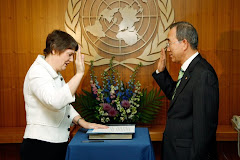Paul Fauvet
8 November 2010
 click here to view this story on all africa.com
click here to view this story on all africa.com
Maputo — The United Nations Development Programme (UNDP) launched its flagship publication, the annual Human Development Report, last week - and although Mozambique's score had improved slightly on the Human Development Index (HDI), it was still classed as one of the least developed places on earth.
Mozambique was placed in 165th position out of the 169 countries covered. Of those 169, the only countries with lower human development than Mozambique were Burundi, Niger, the Democratic Republic of Congo and Zimbabwe.
A few places do not have sufficient data to compile their HDI - and Mozambique would presumably have beaten some of them, since they include Somalia, Eritrea, and North Korea.
The HDI is a composite index - life expectancy accounts for a third, per capita Gross National Income for a third, and educational attainment for a third. Measuring these indicators accurately depends on a reasonably reliable statistical base.
In particular, the index cannot be composed without knowing how many people live in the countries being surveyed. An inaccurate figure for the size of the population will make it impossible to give accurate per capita figures.
And this is exactly what we find in the UNDP. Year after year the global Human Development Report inflates the size of the Mozambican population - and therefore lowers the per capita national income. The latest report states that the Mozambican population reached 23.4 million in 2010.
But that is a million too many. The real figure, according to Mozambique's National Statistics Institute (INE), is 22.4 million. The UNDP thus has an error of around 4.5 per cent, which is far from negligible.
Of course, some countries have dodgy statistics - but Mozambique is not one of them. The INE has won consistent praise, including from the UN. Its figure for the 2010 population is a projection from the 2007 census, the reliability of which has never been questioned.
Indeed, the Maputo offices of UN agencies provided the INE with technical support in the 1997 and 2007 censuses. Yet the UNDP headquarters in New York simply ignores the Mozambican figures.
When this issue was raised at the Maputo launch of the Report last Friday, the interim UNDP representative in Maputo, Jocelyn Mason, brushed it aside on the grounds that the Human Development Report is now fully "independent" of the UNDP. The independent experts who had compiled it, he said, had used "other sources".
This won't do. First, the UNDP publishes the report and presumably pays for it. The UNDP has been happy to take credit for the reports in the past, and mistakes in the report will reflect badly on the UNDP.
Secondly, there are no "other sources". There is only one statistical authority in Mozambique. There was only one census carried out in 2007. Nobody other than the INE goes round, from house to house, counting Mozambicans.
There is nothing new about the UN getting Mozambican population figures wrong. It happens in report after report, despite protests in Mozambique. AIM is aware that on previous occasions UNDP-Maputo has politely pointed the mistake out to UNDP-New York - but to no avail.
Where does the idea that the current population is 23.4 million come from? The Human Development Reports appear to derive their figures by projections from the first post-independence census in 1977, ignoring the censuses of 1997 and 2007, which the "independent experts" have concluded must understate the size of the population.
They thus ignore the catastrophe that struck Mozambique in the 1980s. The combination of war and devastating droughts slowed down the country's population growth rate. By the end of the war of destabilisation in 1992, it was calculated (again, with UN technical assistance) that there had been about a million "excess deaths", mostly among children.
Without the war, Mozambique would have been able to cope with natural disasters, and the death toll would have been far lower. This was dramatically confirmed by the 1997 census. The pre-census estimate, based on projections from the 1977 census, was that there were 18.5 million people in the country. But the 1997 census could only find 16.1 million.
The population did not grow as expected because a million people were taken out in the 1980s. But for the UNDP in New York, those million people are still alive, and their ghosts continue to march through the Human Development Reports year after year.
Does this make a difference? Correct per capita figures would probably improve Mozambique's HDI ranking by a few places, but it would not change the fact that Mozambique remains extremely poor. But if the methodology developed to calculate human development is worth doing at all, then it must be worth doing properly, using the latest, most reliable statistics available. There is certainly no justification for UNDP-New York to ignore work produced by Mozambique's own statisticians.
I first wrote on the subject of the UN bungling its figures in 1999, and see no reason to change a word of my conclusion, which was as follows: "International agencies should have some respect for the institutions in the countries they are supposed to be helping. Census data are a serious matter. They are the building blocks for meaningful planning, and it is the height of arrogance for UN officials in New York to disregard them".
















































No comments:
Post a Comment